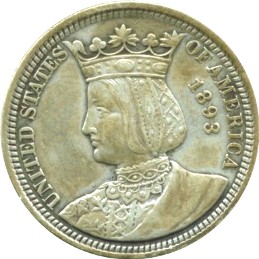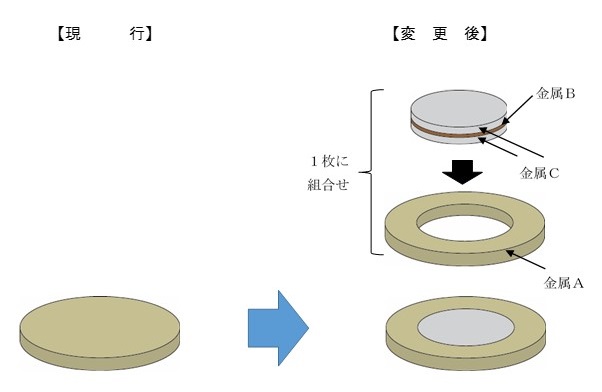|
Library Of Congress Silver Dollar
Library of Congress silver dollar is a commemorative coin issued by the United States Mint in 2000. The coin was part of a two-coin series authorized by commemorating the 200th anniversary of the Library of Congress. Design The obverse of the coin was designed by US Mint engraver Thomas D. Rogers. It features two books, one closed and one open, superimposed over the torch of learning. The reverse was designed by John Mercanti, who had designed many commemorative coins in the past, and features the dome of the Library of Congress' Thomas Jefferson Building. Production and sales Public Law 105–268 authorized a total of 500,000 Library of Congress dollars. Sales of the coin began on April 24, 2000, and when sales ended at the end of the year, 53,264 uncirculated and 198,503 proof coins (both produced at the Philadelphia Mint) were sold. Although more dollar coins were sold than its companion coin, the Library of Congress eagle, it was the latter that became more popula ... [...More Info...] [...Related Items...] OR: [Wikipedia] [Google] [Baidu] |
Silver
Silver is a chemical element with the Symbol (chemistry), symbol Ag (from the Latin ', derived from the Proto-Indo-European wikt:Reconstruction:Proto-Indo-European/h₂erǵ-, ''h₂erǵ'': "shiny" or "white") and atomic number 47. A soft, white, lustrous transition metal, it exhibits the highest electrical conductivity, thermal conductivity, and reflectivity of any metal. The metal is found in the Earth's crust in the pure, free elemental form ("native silver"), as an alloy with gold and other metals, and in minerals such as argentite and chlorargyrite. Most silver is produced as a byproduct of copper, gold, lead, and zinc Refining (metallurgy), refining. Silver has long been valued as a precious metal. Silver metal is used in many bullion coins, sometimes bimetallism, alongside gold: while it is more abundant than gold, it is much less abundant as a native metal. Its purity is typically measured on a per-mille basis; a 94%-pure alloy is described as "0.940 fine". As one of th ... [...More Info...] [...Related Items...] OR: [Wikipedia] [Google] [Baidu] |
2000 Library Of Congress Bimetallic Ten Dollar Coin
The Library of Congress bimetallic eagle is a modern U.S. commemorative coin issued in the ten dollar denomination. It is the first gold and platinum bimetallic coin to be issued by the United States Mint. It was issued in proof and business strike qualities. The issue price was $425 for the proof version and $405 for the uncirculated (business strike) version. Design The bimetallic coin design was inspired by the graceful architecture of the library's Jefferson Building. The outer ring is stamped from a sheet of gold, then a solid core of platinum is placed within the ring. Then, the gold ring and platinum core are simultaneously stamped forming an annular bead where the two precious metals meet. The obverse depicts the hand of Minerva, the Goddess of Wisdom, raising the torch of learning aside the dome of the Thomas Jefferson Building. The coin's reverse is marked with the Library of Congress seal encircled by a laurel wreath, symbolizing its national accomplishment. Specif ... [...More Info...] [...Related Items...] OR: [Wikipedia] [Google] [Baidu] |
United States Dollar Coins
United may refer to: Places * United, Pennsylvania, an unincorporated community * United, West Virginia, an unincorporated community Arts and entertainment Films * ''United'' (2003 film), a Norwegian film * ''United'' (2011 film), a BBC Two film Literature * ''United!'' (novel), a 1973 children's novel by Michael Hardcastle Music * United (band), Japanese thrash metal band formed in 1981 Albums * ''United'' (Commodores album), 1986 * ''United'' (Dream Evil album), 2006 * ''United'' (Marvin Gaye and Tammi Terrell album), 1967 * ''United'' (Marian Gold album), 1996 * ''United'' (Phoenix album), 2000 * ''United'' (Woody Shaw album), 1981 Songs * "United" (Judas Priest song), 1980 * "United" (Prince Ital Joe and Marky Mark song), 1994 * "United" (Robbie Williams song), 2000 * "United", a song by Danish duo Nik & Jay featuring Lisa Rowe Television * ''United'' (TV series), a 1990 BBC Two documentary series * ''United!'', a soap opera that aired on BBC One from 1965-19 ... [...More Info...] [...Related Items...] OR: [Wikipedia] [Google] [Baidu] |
Modern United States Commemorative Coins
The United States Mint has minted numerous commemorative coins to commemorate persons, places, events, and institutions since 1848. Many of these coins are not intended for general circulation, but are still legal tender. The mint also produces commemorative medals, which are similar to coins but do not have a face value, and therefore are not legal tender. History Early commemoratives The earliest commemorative coin minted by the US Mint was the 1848 "CAL" quarter eagle, which commemorated the finding of gold in California. These coins were standard quarter eagles that were modified by punching ''CAL.'' onto the reverse above the eagle. Most standard US commemorative coin lists begin with the 1892 Columbian half dollar commemorating the 400th anniversary of Columbus' voyage to America. The following year, the Columbian Exposition quarter dollar featuring Queen Isabella of Spain was issued. In 1915, the mint issued the Panama–Pacific half union, which had a face value o ... [...More Info...] [...Related Items...] OR: [Wikipedia] [Google] [Baidu] |
United States Commemorative Coins
The United States Mint has minted numerous commemorative coins to commemorate persons, places, events, and institutions since 1848. Many of these coins are not intended for general circulation, but are still legal tender. The mint also produces commemorative medals, which are similar to coins but do not have a face value, and therefore are not legal tender. History Early commemoratives The earliest commemorative coin minted by the US Mint was the 1848 "CAL" quarter eagle, which commemorated the finding of gold in California. These coins were standard quarter eagles that were modified by punching ''CAL.'' onto the reverse above the eagle. Most standard US commemorative coin lists begin with the 1892 Columbian half dollar commemorating the 400th anniversary of Columbus' voyage to America. The following year, the Columbian Exposition quarter dollar featuring Queen Isabella of Spain was issued. In 1915, the mint issued the Panama–Pacific half union, which had a face value o ... [...More Info...] [...Related Items...] OR: [Wikipedia] [Google] [Baidu] |
Library Of Congress Bimetallic Eagle
The Library of Congress bimetallic eagle is a modern U.S. commemorative coin issued in the ten dollar denomination. It is the first gold and platinum bimetallic coin to be issued by the United States Mint. It was issued in proof and business strike qualities. The issue price was $425 for the proof version and $405 for the uncirculated (business strike) version. Design The bimetallic coin design was inspired by the graceful architecture of the library's Jefferson Building. The outer ring is stamped from a sheet of gold, then a solid core of platinum is placed within the ring. Then, the gold ring and platinum core are simultaneously stamped forming an annular bead where the two precious metals meet. The obverse depicts the hand of Minerva, the Goddess of Wisdom, raising the torch of learning aside the dome of the Thomas Jefferson Building. The coin's reverse is marked with the Library of Congress seal encircled by a laurel wreath, symbolizing its national accomplishment. Specifi ... [...More Info...] [...Related Items...] OR: [Wikipedia] [Google] [Baidu] |
Bi-metallic Coin
Bi-metallic coins are coins consisting of two (''bi-'') metals or alloys, generally arranged with an outer ring around a contrasting center. Common circulating examples include the €1, €2, United Kingdom £1 and £2, Canadian $2, South Africa R5, Turkish 1 lira and 50 kurus, Indian ₹10 and ₹20, IDR 1K, 2 and 5 PLN, 50 CZK, 100 and 200 HUF, 1 and 2 BGN, Hong Kong $10, Argentine $1 and $2, Brazilian R$1, Chilean $100 and $500, Colombian $500 and $1000, and all Mexican coins of $1 or higher denomination. History Bi-metallic coins and medals have been issued for a long time. The Roman Empire issued special-occasion, large medallions with a center of bronze or copper and an outer ring of orichalcum, starting with the reign of Hadrian. Meanwhile, circulating bi-metallic coins are known from the 17th century. English farthings from 1684 through 1693 were made of tin with a central plug of copper for value. The silver-center cent pattern produced by the U ... [...More Info...] [...Related Items...] OR: [Wikipedia] [Google] [Baidu] |
Philadelphia Mint
The Philadelphia Mint in Philadelphia was created from the need to establish a national identity and the needs of commerce in the United States. This led the Founding Fathers of the United States to make an establishment of a continental national mint, a main priority after the ratification of the Constitution of the United States. The Coinage Act of 1792 was entered into law on April 2. It proclaimed the creation of the United States Mint. Philadelphia at that time was the nation's capital; therefore the first mint facility was built there. The Coinage Act of 1792 also instituted a decimal system based on a dollar unit; specified weights, metallic composition and fineness; and required each United States coin feature "an impression emblematic of liberty". History First building (1792–1833) David Rittenhouse, an American scientist, was appointed the first director of the mint by President George Washington. Two lots were purchased by Rittenhouse on July 18, 1792, at Sevent ... [...More Info...] [...Related Items...] OR: [Wikipedia] [Google] [Baidu] |
Copper
Copper is a chemical element with the symbol Cu (from la, cuprum) and atomic number 29. It is a soft, malleable, and ductile metal with very high thermal and electrical conductivity. A freshly exposed surface of pure copper has a pinkish-orange color. Copper is used as a conductor of heat and electricity, as a building material, and as a constituent of various metal alloys, such as sterling silver used in jewelry, cupronickel used to make marine hardware and coins, and constantan used in strain gauges and thermocouples for temperature measurement. Copper is one of the few metals that can occur in nature in a directly usable metallic form ( native metals). This led to very early human use in several regions, from circa 8000 BC. Thousands of years later, it was the first metal to be smelted from sulfide ores, circa 5000 BC; the first metal to be cast into a shape in a mold, c. 4000 BC; and the first metal to be purposely alloyed with another metal, tin, to create ... [...More Info...] [...Related Items...] OR: [Wikipedia] [Google] [Baidu] |
Proof Coinage
Proof coinage refers to special early samples of a coin issue, historically made for checking the dies (as in demonstrating that something is true) and for archival purposes. Nowadays proofs are often struck in greater numbers specially for coin collectors (numismatists). Nearly all countries have issued proof coinage. Preparation of a proof striking usually involved polishing of the dies. They can usually be distinguished from normal circulation coins by their sharper rims and design, as well as much smoother "fields" – the blank areas not part of the coin's design. The dies for making modern proof coins are often treated with chemicals to make certain parts of the design take on a frosted appearance, with the polished fields taking on a mirror finish. Several other methods have been used in the past to achieve this effect, including sand blasting the dies, and matte proofs. Proof coins of the early 19th century even appear to be scratched, but it was part of the production ... [...More Info...] [...Related Items...] OR: [Wikipedia] [Google] [Baidu] |





.jpg)